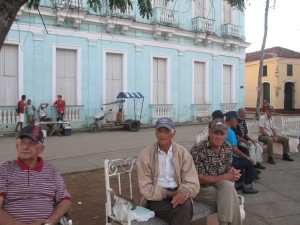Unlike the other Colonial towns established by the Spanish in the mid 1500s (Cartagena, Colombia; Granada, Nicaragua; Leon, Nicaragua; Antigua, Guatemala), the Remedios colonial heritage is quite large. The center square is more airy than typical. Houses are characterized by very tall doors and windows, fronted by wrought iron grill work. The streets are remarkably clean. The buildings are well preserved, but far from pristine, which gives them a lot of character and appeal.
It seems that Remedios has been skipped in the circuit of tourism and therefore the local population still has that appetite for interface with the outside world. There is a slightly older generation hanging around the park benches, eager to engage in conversation and tell the tale of the “Playa de Giron” — i.e. the U.S. failed Bay of Pigs invasion.
What strikes us, repeatedly, is the level of intellectual, or let’s say intelligent discourse.
These two stunningly beautiful (inside and out) sisters were eager to chat and Danielis (on right) asks if I (Peta) have an email for her to write to as the local post office has recently received internet access. The first in town. I give her mine and Adams’ so he can practice his Spanish and she can have a penpal in the US.
This Remedios resident was born in this house and has lived here his whole life, which is not atypical.
The Casa Particular where we stay is grander than any we have stayed in so far. Excellent meals prepared with a lot of attention, but most importantly, a classy feel, with beautiful period furniture.
The highlight of Remedios however was the last day’s escapade to the beach. We flagged a bici-taxi to take us the 7km to the local beach. Problem one: beach was “for Cubans only”. As we have established, we have no problem ignoring rules and we opted to see what it was like, to our Casa Particular’s owner’s distress.
The 7km ride took us past fields of sugar canes, rice paddies, cows & goats. We stop at another municipal, coop organic farm where we buy bokchoy and lettuce, getting an education on how the grass-roots coop operates. Being on the Bicitaxi allowed us to move at a slow pace, Cuba style, through the country style, taking in all the vignettes.
The beach was not grand, the sand was dark, concrete unbrellas in disrepair, abandoned because it’s the “winter” (but apparently packed with locals in summer). On the way back, we stop to try out the sugar cane, which the driver cuts down for us by machete. We drink fresh coconut water. The driver, stops by his brothers’ house where everyone is congregated outside preparing a large family meal and we are invited to share some of the fried fish.
All in all, we spent most of the day slowly moving through the countryside, talking to people along the way and getting a feel for their lives.

























